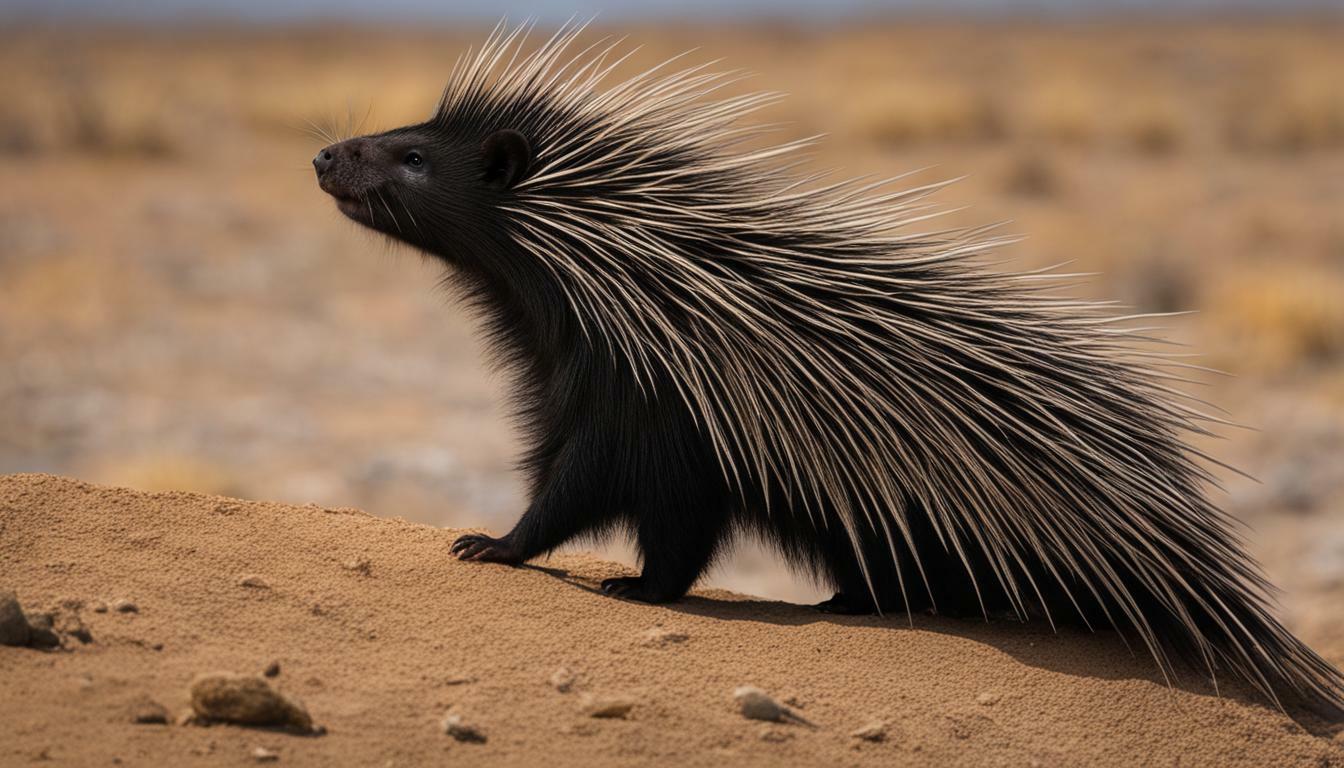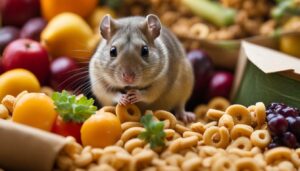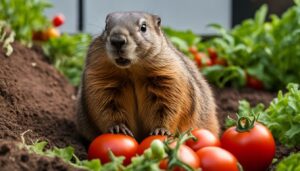The conservation status of African porcupines, specifically the African crested porcupine, is a topic of interest for wildlife enthusiasts and conservationists. While these porcupines are not currently listed as endangered, they still face threats to their survival, including habitat loss and hunting.
African porcupines, prized for their meat and quills used in decoration and jewelry, are hunted by humans. However, efforts are being made to protect them and their habitats. Stricter regulations on porcupine hunting and preservation of their habitats are being implemented to ensure their long-term survival. Despite their current non-endangered status, African porcupines still need our help and support.
Key Takeaways:
- African porcupines, specifically the African crested porcupine, are not currently listed as endangered.
- They face threats such as habitat loss and hunting.
- Humans hunt African porcupines for their meat and quills used in decoration and jewelry.
- Conservation efforts include stricter regulations on porcupine hunting.
- Preservation of their habitats is crucial for ensuring their survival.
African Porcupine Population and Conservation
Understanding the population size and conservation status of African porcupines is crucial for evaluating their vulnerability to extinction. The African crested porcupine, a species of porcupine found in Africa, is not currently listed as endangered. However, despite this classification, these fascinating creatures still face numerous challenges that threaten their survival.
One significant threat to African porcupines is habitat loss. With the expansion of human settlements, their natural habitats are being encroached upon and destroyed. This puts pressure on the porcupine populations, forcing them to adapt to new environments or risk decline. Additionally, illegal hunting poses a significant danger to these porcupines. They are hunted for their meat, considered a delicacy in some regions, and their quills, which are used for decoration and jewelry.
Conservation efforts are underway to protect African porcupines and their habitats. Strict regulations have been implemented to control porcupine hunting and prevent overexploitation. These measures aim to protect the population size and ensure sustainable hunting practices. Furthermore, habitat preservation initiatives play a crucial role in safeguarding porcupine populations. By conserving and restoring their natural habitats, we can create safe spaces for African porcupines to thrive.
| Challenges | Conservation Measures |
|---|---|
| Habitat loss due to human activities | Habitat preservation initiatives |
| Illegal hunting for meat and quills | Strict regulations on porcupine hunting |
| Risk of population decline | Sustainable hunting practices |
While African porcupines are not currently classified as endangered, it is important to recognize that their survival still relies on our collective efforts. By raising public awareness about their conservation status and involving local communities in conservation initiatives, we can work towards ensuring the long-term viability of these unique creatures. Together, we can protect African porcupines and preserve the natural biodiversity of our planet.
African Porcupine Habitats and Threats
The habitats in which African porcupines reside play a significant role in their survival, while various threats pose challenges to their existence. These remarkable creatures are adaptable and can be found in a variety of habitats across Sub-Saharan Africa, including forests, savannas, grasslands, and rocky areas. They are known to thrive in diverse ecosystems, from the dense rainforests of West Africa to the arid regions of Southern Africa.
However, habitat loss is a major threat to African porcupines. Rapid urbanization, agricultural expansion, and deforestation have led to the destruction and fragmentation of their natural habitats. As a result, these porcupines are increasingly forced to navigate human-dominated landscapes, which exposes them to additional risks and reduces the availability of suitable food and shelter.
Furthermore, African porcupines face threats from various predators, including lions, leopards, hyenas, and humans. These predators view porcupines as a potential source of food and may actively hunt them. In some areas, porcupines are also targeted by humans for their meat and quills. The meat is considered a delicacy in certain cultures, while the quills are used for decorative and jewelry purposes.
Threats to African Porcupines:
- Habitat loss due to urbanization, agriculture, and deforestation.
- Predation by lions, leopards, hyenas, and humans.
- Hunting for meat and quills.
| Habitat | Threats |
|---|---|
| Forests | Deforestation, logging |
| Savannas | Land conversion for agriculture, human encroachment |
| Grasslands | Conversion to pastureland, habitat fragmentation |
| Rocky areas | Quarrying, mining |
“The habitats in which African porcupines reside play a significant role in their survival, while various threats pose challenges to their existence.” – African Wildlife Conservation Society
Conservation efforts are vital to safeguard the future of African porcupines and their habitats. Strict regulations on porcupine hunting, including limits on hunting seasons and quotas, are in place to prevent overexploitation. These regulations aim to ensure that the hunting of porcupines is sustainable and does not impact their population numbers.
Additionally, habitat preservation efforts are crucial to provide suitable environments for African porcupines to thrive. Conservation organizations work to protect and restore their habitats, focusing on initiatives such as reforestation, establishment of protected areas, and community-based conservation programs. By safeguarding these habitats, we can help maintain the delicate balance of ecosystems and ensure the survival of African porcupine populations for future generations.
Conservation Measures for African Porcupines:
- Regulation on porcupine hunting to prevent overexploitation.
- Habitat preservation through reforestation and protected area establishment.
- Community-based conservation programs to involve local communities in conservation efforts.
| Conservation Measure | Purpose |
|---|---|
| Regulation on porcupine hunting | Prevent overexploitation |
| Habitat preservation | Provide suitable environments for porcupines |
| Community-based conservation programs | Involve local communities in conservation efforts |
Hunting of African Porcupines
African porcupines are sought after for their meat and decorative quills, leading to concerns about their population decline. These fascinating creatures are often hunted for their tasty meat, which is considered a delicacy in some regions. Additionally, their quills are highly valued for their use in making decorative items and jewelry.
Unfortunately, this demand for porcupine meat and quills has put immense pressure on their populations. Unregulated hunting practices have resulted in a significant decline in their numbers, threatening their long-term survival. Conservationists and wildlife authorities are actively working to address these issues and protect African porcupines.
In response to the declining population, strict regulations have been implemented to control porcupine hunting. These regulations help ensure that hunting practices are sustainable, allowing for population recovery. By limiting the number of porcupines that can be harvested, authorities aim to strike a balance between human needs and wildlife preservation.
Furthermore, raising awareness about the importance of protecting African porcupines has become a crucial part of conservation efforts. Public education campaigns and community involvement are essential in reducing the demand for porcupine products and promoting sustainable alternatives. Through increased awareness and responsible hunting practices, we can help safeguard the future of African porcupines and preserve their unique place in the ecosystem.
| Hunting Threats | Conservation Measures |
|---|---|
| Unregulated hunting practices | Strict regulations on porcupine hunting |
| Population decline | Public education campaigns on wildlife conservation |
| Loss of habitat | Community involvement in habitat preservation |
Conservation Efforts for African Porcupines
Recognizing the threats faced by African porcupines, conservation efforts have been implemented to protect their populations from decline. These majestic creatures, while not currently listed as endangered, still require our attention and support. Efforts are underway to ensure the long-term survival of African porcupines through a combination of strict hunting regulations and habitat preservation initiatives.
Hunting of African porcupines is a significant concern for their conservation. These animals are sought after for their meat, which is considered a delicacy in some regions, and for their quills, which are used in the production of decorative items and jewelry. To combat this threat, strict regulations have been put in place to control porcupine hunting activities. These regulations aim to protect the porcupine population from overexploitation and ensure sustainable use of their resources.
In addition to hunting regulations, preserving the natural habitats of African porcupines is crucial for their survival. Habitat loss due to deforestation, urbanization, and agricultural expansion poses a significant threat to their populations. Efforts are being made to protect and restore their habitats, including the establishment of protected areas and the implementation of sustainable land-use practices. These initiatives not only benefit the porcupines but also support the overall biodiversity and ecological balance of the ecosystems in which they reside.
Public awareness and involvement play a vital role in the success of conservation efforts for African porcupines. Educating communities about the importance of preserving these animals and their habitats is key to fostering a sense of responsibility and promoting sustainable practices. Encouraging local communities to participate in conservation activities, such as habitat restoration projects and wildlife monitoring, strengthens the connection between people and nature, fostering a sense of ownership and pride in protecting these incredible creatures.
| Conservation Efforts for African Porcupines | Impact |
|---|---|
| Strict regulation of hunting | Prevents overexploitation and ensures sustainable use of porcupine resources |
| Habitat preservation initiatives | Protects natural habitats, supports overall biodiversity, and ensures long-term survival of porcupine populations |
| Public awareness and involvement | Educates communities, fosters a sense of responsibility, and promotes sustainable practices |
Regulation of Porcupine Hunting
To mitigate the impact of hunting on African porcupines, strict regulations have been put in place to control hunting practices. These regulations aim to protect the population of African porcupines and ensure their long-term survival. By implementing these measures, authorities are working towards preventing the decline of African porcupine numbers.
The hunting of African porcupines is closely monitored and regulated to prevent overexploitation. In many countries, hunting permits are required, and quotas are established to limit the number of porcupines that can be harvested. These regulations help maintain a balance between sustainable hunting practices and the conservation of African porcupines.
Authorities also collaborate with local communities to raise awareness about the importance of protecting African porcupines. Education programs and outreach initiatives are conducted to inform communities about the ecological role of porcupines and the potential consequences of their decline. By involving local communities in conservation efforts, there is a greater chance of success in promoting responsible hunting practices and preserving porcupine habitats.
In addition to hunting regulations, efforts are made to enforce strict penalties for poaching and illegal trade of African porcupines. This helps deter illegal activities and serves as a deterrent to those who may engage in activities that threaten the survival of these remarkable creatures.
| Regulation Measures | Impact |
|---|---|
| Hunting permits and quotas | Controlled hunting practices to prevent overexploitation |
| Collaboration with local communities | Increased awareness and participation in conservation efforts |
| Strict penalties for poaching | Deterrence and protection against illegal activities |
Through the implementation of these regulations and conservation strategies, it is hoped that African porcupine populations can be safeguarded, ensuring their presence in the wild for future generations.
Habitat Preservation for African Porcupines
Preserving the natural habitats of African porcupines is vital for maintaining their populations and protecting their overall well-being. These unique creatures rely on specific environments for their survival, which makes habitat conservation crucial to their long-term existence.
African porcupines primarily inhabit woodlands, grasslands, and savannas across sub-Saharan Africa. These diverse ecosystems offer the necessary resources for their sustenance, including a variety of vegetation for grazing, as well as suitable shelter and burrows for protection.
Habitat loss poses a significant threat to African porcupines. As human populations expand, forests are cleared for agriculture, infrastructure development, and other purposes, leading to the destruction and fragmentation of their natural habitats. This fragmentation disrupts the porcupines’ movement patterns and reduces their access to food and shelter, ultimately impacting their population size.
To mitigate these threats, conservation organizations and governmental bodies are implementing various strategies. These include establishing protected areas and reserves that preserve the porcupines’ habitats, restricting land use practices that contribute to habitat destruction, and promoting sustainable land management practices that balance human needs with wildlife conservation.
| Habitat Preservation for African Porcupines |
|---|
| Preserve woodlands, grasslands, and savannas |
| Protect resources for sustenance |
| Prevent habitat loss and fragmentation |
| Establish protected areas and reserves |
| Restrict destructive land use practices |
| Promote sustainable land management |
The Role of African Porcupines in Ecosystems
African porcupines play a crucial role in maintaining the balance and integrity of ecosystems they inhabit. These remarkable creatures have a significant impact on their environment, influencing vegetation patterns and contributing to nutrient cycling. Their foraging behavior and feeding habits help shape the structure of plant communities and promote biodiversity.
One of the key contributions of African porcupines to ecosystems is their role as seed dispersers. As they feed on a variety of plant material, including fruits, bulbs, and roots, they inadvertently transport seeds over long distances. This dispersal mechanism aids in the colonization of new areas and contributes to the regeneration and diversity of plant species.
In addition, African porcupines are known for their ability to excavate burrows. These burrows not only provide shelter for the porcupines themselves but also serve as habitat for various other animal species. In fact, studies have shown that the presence of porcupine burrows enhances species richness and diversity by creating nesting sites and refuges for small mammals, reptiles, and amphibians.
| Porcupines and Ecosystems | Ecosystem Benefits |
|---|---|
| Seed Dispersal | Promotes plant diversity and colonization of new areas |
| Burrow Excavation | Provides shelter and habitat for other animal species |
| Nutrient Cycling | Contributes to the recycling of nutrients in the soil |
- Seed Dispersal: African porcupines unintentionally transport seeds, aiding in plant colonization and diversity.
- Burrow Excavation: Porcupine burrows provide shelter for other animal species, promoting habitat diversity.
- Nutrient Cycling: Porcupine foraging activities contribute to the recycling of nutrients in the soil.
However, the survival of African porcupines is threatened by habitat loss and hunting. The destruction of their natural habitats through deforestation and agricultural expansion reduces the availability of suitable areas for them to thrive. Additionally, hunting for their meat and quills poses a significant risk to their populations.
Conservation efforts are crucial to protect African porcupines and ensure the preservation of their habitats. Strict regulations on porcupine hunting, combined with habitat preservation initiatives, are essential in maintaining healthy porcupine populations and protecting their vital role in the ecosystems they inhabit. By recognizing the ecological significance of this species and raising public awareness about their conservation needs, we can contribute to their long-term survival and the overall health of our ecosystems.
African porcupines may not be currently listed as endangered, but they still require our attention and support. Together, we can work towards safeguarding these unique creatures and the ecosystems they call home.
| Habitat Loss and Hunting | Conservation Efforts |
|---|---|
| Threatens porcupine populations | Strict regulation of porcupine hunting |
| Reduces suitable habitats | Habitat preservation initiatives |
Public Awareness and Involvement
Promoting public awareness and active participation are essential in securing a future for African porcupines and their habitats. By increasing awareness about the conservation needs of these unique creatures, we can encourage people to take action and support initiatives aimed at protecting their populations.
One way to raise public awareness is through educational programs and campaigns that highlight the importance of African porcupines in maintaining the balance of ecosystems. These programs can provide information about their behaviors, habitats, and the threats they face, helping people understand the critical role these animals play in the natural world.
Another effective strategy is to engage local communities in conservation efforts. This can be done by encouraging community-led initiatives, such as habitat restoration projects or the establishment of protected areas. By involving people directly in conservation activities, we can foster a sense of ownership and responsibility, ensuring the long-term sustainability of these efforts.
Furthermore, fostering partnerships and collaborations between government agencies, conservation organizations, and local communities is crucial. These partnerships can facilitate the exchange of knowledge, resources, and expertise, leading to more effective conservation strategies. Together, we can work towards creating a future where African porcupines thrive in their natural habitats, benefiting not only these incredible creatures but also the broader ecosystems they inhabit.
| Ways to Promote Public Awareness and Involvement: | Benefits: |
|---|---|
| Implement educational programs and campaigns | Increased understanding of African porcupines and their conservation needs |
| Engage local communities in conservation activities | Building a sense of responsibility and ownership |
| Promote partnerships and collaborations | Enhanced conservation efforts through shared knowledge and resources |
Conclusion
While African porcupines are not currently classified as endangered, their conservation remains crucial due to the threats they face in the wild. These remarkable creatures, particularly the African crested porcupine, still face challenges such as habitat loss and hunting.
Habitat destruction is a significant concern for African porcupines. As human populations expand and encroach upon their natural habitats, these animals are losing their homes. Without suitable habitats, their populations can decline, leading to long-term consequences for ecosystems.
Additionally, hunting poses a significant threat to African porcupines. These animals are hunted for various purposes, including meat consumption and the use of their quills for decoration and jewelry. To protect them, regulations have been implemented to govern porcupine hunting and ensure sustainable practices.
Conservation efforts are underway to safeguard African porcupines and their habitats. Strict regulation of hunting practices, coupled with habitat preservation initiatives, aims to protect these unique animals and ensure their long-term survival. While they may not be classified as endangered, their existence is vital to maintaining balanced ecosystems and preserving biodiversity.
FAQ
Are African porcupines endangered?
No, African porcupines, specifically the African crested porcupine, are not currently listed as endangered. However, they still face threats to their survival such as habitat loss and hunting.
What are the threats to African porcupines?
African porcupines face threats such as habitat loss and hunting. They are hunted for their meat and quills, which are used for decoration and jewelry.
What conservation efforts are being made to protect African porcupines?
Conservation efforts for African porcupines include strict regulation of porcupine hunting and habitat preservation efforts.
Why are African porcupines hunted?
African porcupines are hunted for their meat and quills, which are valued for decoration and jewelry purposes.
How can I help protect African porcupines?
You can contribute to the conservation of African porcupines by supporting organizations and initiatives focused on their protection, raising awareness about their importance, and promoting sustainable practices.




